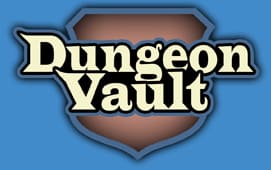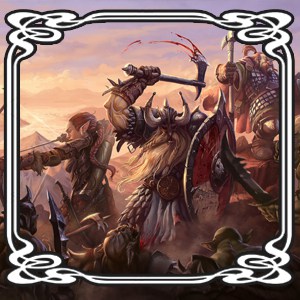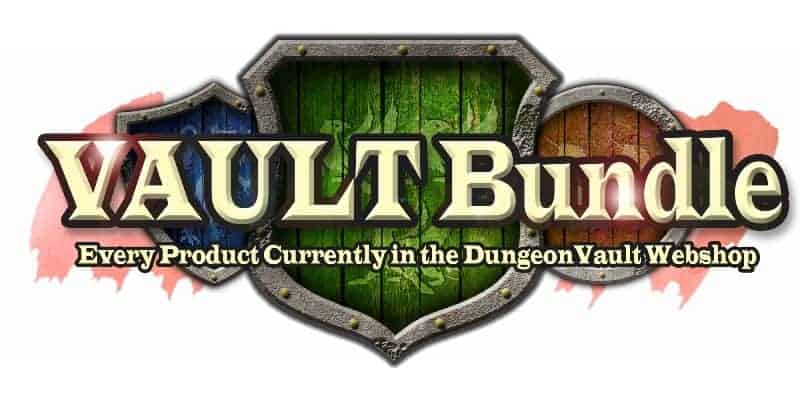A one shot is a single D&D session that usually lasts about 4 hours. One shots offer a great breather between campaigns. Because time is limited, they should focus on fast-paced challenges. D&D puzzles are perfect for one shots IF you pick the right puzzles. Choose the wrong puzzles for your D&D one shot, and your players will feel stuck and your game will slow down. So what are the right puzzles?
D&D Puzzles for One Shots to Avoid
There are two types of puzzles that are less than ideal for D&D one shots. Those are:
- Puzzles that take a long time to explain.
- Puzzles that take a long time to solve.
The power of a great one shot is that it takes players for a ride, where new events unfold in rapid succession. You could, of course, plan for a slower one shot, but four hours of game time is gone in the blink of an eye. Most of the time you can do less with that time than you planned for.
So let’s say you have four hours for your one shot. If you spend 15 minutes explaining the rules of a puzzle, that feeling of being swept up by events quickly dies down. Also, 15 minutes is one-sixteenth of a four-hour session.
The same is true for using puzzles that take too long to solve. You could, in theory, give your players a puzzle that takes half an hour to solve. But wouldn’t it be much cooler if players solve three different puzzles in that same amount of time?
A good one shot puzzle for D&D takes about 5 to 10 minutes to explain AND solve. That way, in just an hour’s time, you can present your players with 6 different challenges. Throw in some other types of quick challenges, add a bit of time for role-play and describing scenes, and by the end of your 4 hour one shot, they’ll have played through about 15 to 20 challenges! Your players won’t believe how much they accomplished in such a short period of time.
Quick One Shot Puzzles and A Tight Plan
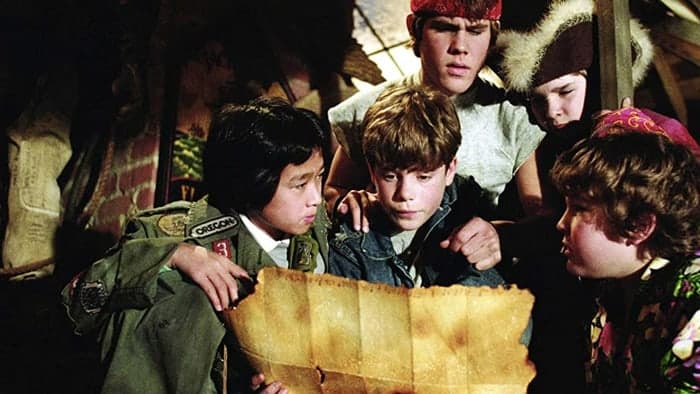
To gain some inspiration for quick gameplay where events unfold at a rapid pace, you might want to check out classic movies such as Mission Impossible, the Goonies, or the intro to ‘Indiana Jones and the Temple of Doom’. Just five minutes into the movie Indie has already been poisoned, shot at, jumped through a window, chased, and jumped out of an airplane with only a lifeboat for a parachute. That’s how you run a fantastic one shot!
For a more puzzle-oriented fast-paced movie that can serve as inspiration for a one shot, check out the Goonies. These kids solve one puzzle after the other to find the hidden treasure. But in order to run these types of stories successfully, you will need a tight plan.
For one shots, I like to time my entire game. I’ll use puzzles from my Vault Bundle pack for this example:
Hour 1
15 minutes: Introduction opening scene.
15 minutes: Chase challenge
10 minutes: Runestone Puzzle
10 minutes: Lock Puzzle
10 minutes: Solve 3 Riddles
Hour 2
10 minutes: Wilderness Puzzle
40 minutes: Combat encounter
10 minutes: Floor Puzzle
Hour 3
15 minutes: Social encounter
10 minutes: Potion Puzzle
10 minutes: Laser Puzzle
10 minutes: Elemental Puzzle
15 minutes: Downtime
Hour 4
10 minutes: Dungeon Puzzle
5 minutes: Climbing skill challenge
45 minutes: Big boss fight
As you can see, a tight plan will help you lay out the series of challenges players face. In slower-paced one shots, you can only pack in an often too lengthy introduction, one combat encounter and one social encounter. But with a fast-paced one shot, you want to plan each of these to be immersive, but take up very little time. (If you wish to layer multiple puzzles of the same type in a dungeon, check out my door puzzles article instead).
So prepare your descriptions to be short and sweet, prepare your combat to be quick and brutal. But above all, prepare your puzzles to be set up and explained very quickly. Here’s how you do that.
Preparing your Puzzles for a D&D One Shot
Every puzzle consists of three elements:
1. The introduction explains how the puzzle works and makes it plausible within your game world. For the puzzles in this example, I’ve included multiple ways to integrate them into your story in the instruction manual.
2. The puzzle itself that players need to solve. The puzzles I use are available in printable and virtual tabletop format. So you can set them up ahead of time and presenting them to your players will only take seconds of game time.
3. The outcome. Solving the puzzle can open a door, reveal a hidden path, trigger a social encounter and so on. Whatever the outcome is, make sure PCs feel urgency to get to the next part of their journey.
Here’s an example:
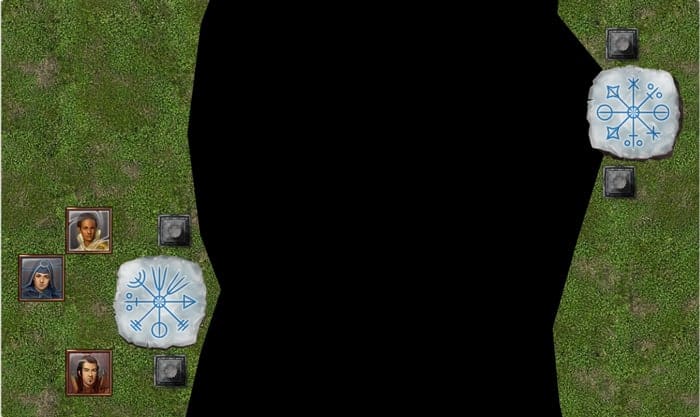
“Having stolen the Runestones of Qualish from the Temple of Uhr, the cultist gave chase. You have managed to lose them for now, but on this small island, it won’t be long before they find you. Here, where the chasm is least wide, you find two large stepping stones that look similar to your runestones, almost as if both sides mark the beginning of a bridge. The little gnome, Ikmel, confirms your suspicions. If you layout the pocket-sized runestones in a way that equal symbols touch, they will magically transform into a floating bridge! But you have to hurry.”
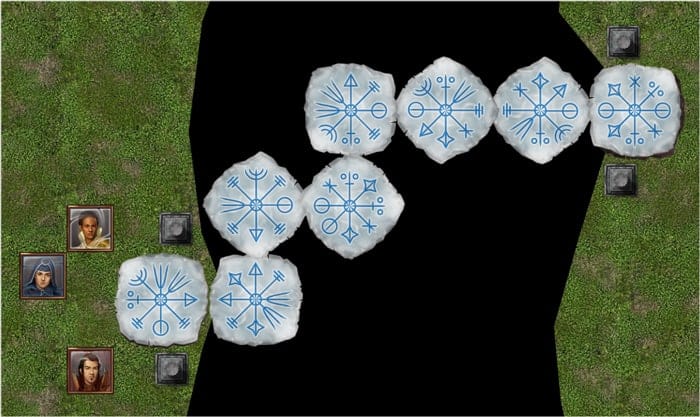
If the players solve this one shot puzzle the result will look like this. Solving the puzzle will take the party about 5 minutes. The outcome here is that the players can cross the bridge, but so can the cultist chasing them, which brings them to the next puzzle to solve.
Troubleshooting your D&D Puzzle One Shot
The worst thing that can happen in a puzzle one shot is your players getting stuck. One way to deal with this is by allowing hints. There’s a couple of ways you can deal with this problem.
One way is to allow players hints. A successful intelligence check yields a hint and the game continues. In the end you tally the number of hints used and deduct that number from a score of one hundred. Let’s say a group of players used 11 hints during the game.
Their score would be: 100 – 11 = 89.
Of course, this challenges the players and not their characters. To challenge both, you can give PCs a number of free hints equal to their intelligence modifiers.
Now you might be thinking to create options to bypass puzzles altogether. Maybe players can fight the cultist instead of solving the puzzle? While that’s a great idea in a campaign, in a one shot you are pressed for time. Exchanging a ten-minute puzzle for a forty-minute combat encounter, means your one shot is going to run half an hour long.
Which Puzzles to Choose for your D&D One Shot?
Running a D&D puzzle one shot requires a lot of different puzzles that must also be presented to the players quickly. And you can’t just throw a sudoku at your players and pretend it’s a puzzle that’s an integral part of your D&D world. That will break the immersion faster than you can seduce a dragon.
Luckily the puzzles I design are richly illustrated and easy to integrate and explain. And in the Vault Bundle there are over ten different types of puzzles to choose from, each designed to improve game immersion. Now the most difficult of these puzzles do take a long time to solve. But if you pick the first puzzles in each pack you can create a very quick one shot. Finally, the vault bundle doesn’t only have puzzles. It also has a deck of 101 riddles, and a book called ‘the prepless GM’ which teaches you how to create other challenges such as exciting chases, escape rooms, (murder) mysteries, and much more on the fly. It’s more than enough to fill a one shot or even a campaign or two.
By Paul Camp
Image: WotC, Roll20
